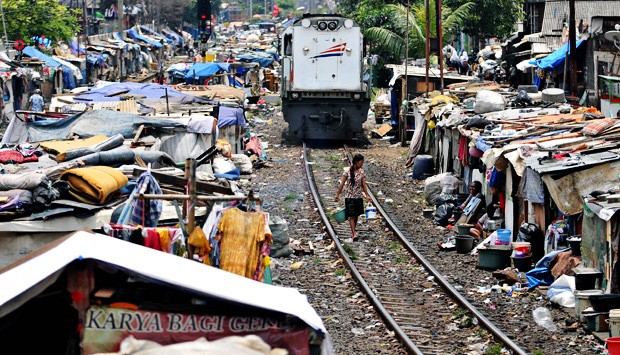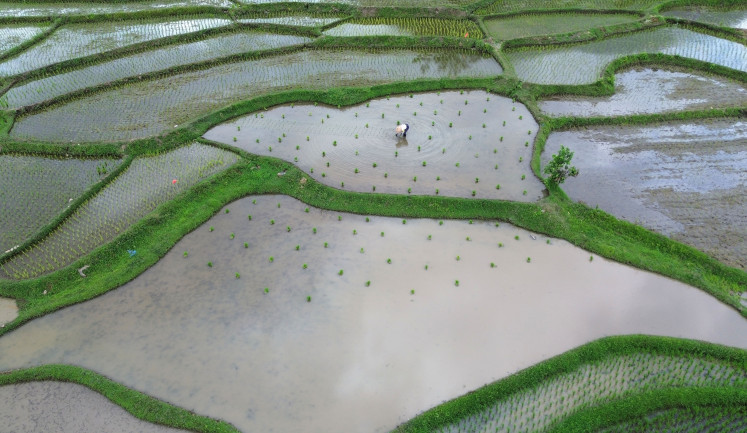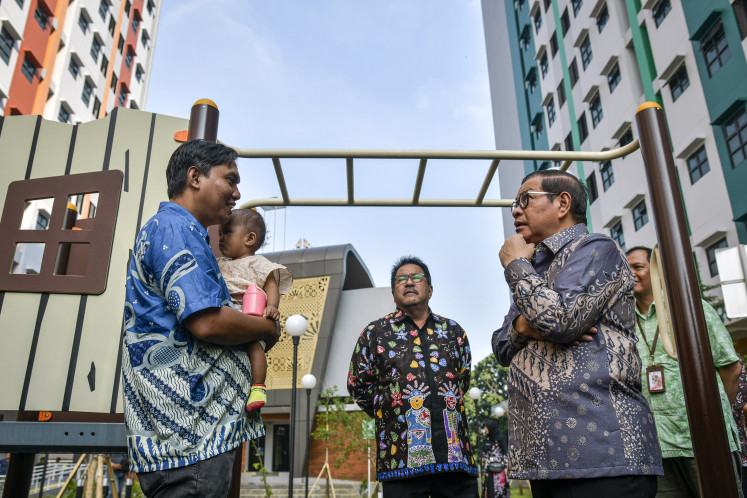Popular Reads
Top Results
Can't find what you're looking for?
View all search resultsPopular Reads
Top Results
Can't find what you're looking for?
View all search resultsBehind the rise of income inequality in Indonesia
Income inequality in Indonesia is now worse than in Thailand, Vietnam, Cambodia and Laos, although it is better than in the Philippines and China. According to a recent World Bank report, only 20 percent of Indonesians benefitted from the growing economic wealth during the last decade, while 80 percent — or about 205 million people — were left behind. According to the World Bank, Indonesia has one of the highest wealth concentrations in the world. The richest 10 percent of Indonesians own an estimated 77 percent of the country’s wealth. Half of the country’s assets are owned by the richest 1 percent.
Change text size
Gift Premium Articles
to Anyone
T
he controversy over the Jakarta Bay land reclamation project that has triggered months of national debate seems to center on several critical issues. But the reclamation saga is not only about legal, environmental, corruption and human rights issues, as it appears on the surface.
The root cause of the conflict lies much deeper. It is about the glaring inequality of income and wealth between the desolate and poor people in northern Jakarta ( most of whom are low-level workers or fishermen ) and the super rich, who reside in the luxurious and glittering residential areas nearby.
What happened in North Jakarta is a reflection of what has taken place all over the country. It is the result of what went wrong in Indonesia’s economic journey for the last 10 years. While the economy experienced a high rate of growth, the income gap between the rich and the poor kept rising.
Indonesia’s Gini coefficient, an indicator of income inequality in a country, rose from 0.3 in 2000 to 0.40 in 2015. ( The higher the Gini coefficient, the more unequal the distribution of income ).
Income inequality in Indonesia is now worse than in Thailand, Vietnam, Cambodia and Laos, although it is better than in the Philippines and China.
According to a recent World Bank report, only 20 percent of Indonesians benefitted from the growing economic wealth during the last decade, while 80 percent — or about 205 million people — were left behind.
According to the World Bank, Indonesia has one of the highest wealth concentrations in the world. The richest 10 percent of Indonesians own an estimated 77 percent of the country’s wealth. Half of the country’s assets are owned by the richest 1 percent. Worse, the concentration of wealth is increasing faster than in other countries. Income from these assets sometimes is taxed at a lower rate than worker income and has a much lower rate of tax compliance.
This means the rich are able to save a larger percentage of their income, increasing inequality in the future. The figures are based on several surveys, but it is known that getting the rich households as survey respondents is more difficult than getting answers from the poor. It is likely that the outcome of the surveys understates the extent of the wealth concentration, so that the actual wealth concentration is worse than stated in the surveys.
How has this inequality come about? The most obvious evidence is the inequality in opportunities. Children from poor households do not have the same opportunities in education as children of the rich. Children of the rich go to high-quality but expensive schools, while the children of the poor go to mediocre schools. The quality of education they receive will determine their future careers.
Moreover, because of poor nutrition and inadequate sanitation, children from poor families are generally less healthy. For instance, 37 percent of Indonesian children are stunted, which impairs their cognitive development. This will impact their future, because when they enter the job market, they will have a low level of skills.
Inequality is equally visible in the labor market. The relatively high growth of the Indonesian economy has created a severe imbalance in the labor market, where demand for skilled workers is high amidst an abundant supply of low-skilled workers.
As a result, a dichotomy in the labor market has developed: High-salary, formal jobs for highly qualified workers on the one hand and informal, low-wage jobs requiring low skills on the other.
Unequal access to skills and rising wages for the skilled has increased wage inequality. This inequality is set to rise, as the rapid growth of the service sector and digital economy changes the structure of the economy for the benefit of those with highly specialized skills.
Various shocks ( financial crises, crop failures, sudden illness or natural disasters ) can hurt the income of the poor and rich alike. However, the rich households have access to mechanisms to cope with shocks, like digging into their savings or insurance. But poor households must rely on loans from friends and families or sell productive assets. This erodes their ability to earn income and invest in the health and education needed to climb up the economic ladder.
It is possible that government policies will in the long term narrow the income gap. Infrastructure projects, which are labor intensive, support for labor-intensive industries, rising salaries of government employees or even the controversial increase in minimum wages and various social programs in education and health could help reduce income inequality. But given the current extreme inequality in income, the impact of those programs would be insignificant.
The widening gap in income should open our eyes to the failure of tax policies as an instrument of income distribution. Tax compliance remains low and tax evasion among high earners is still common. This raises the question of equity; because the effective tax rate paid by the wealthy is lower than that paid by low earners.
To let this situation prevail is fiscally irresponsible and morally unjustifiable. Also, massive corruption in the form of bribes, kickbacks that have siphoned off trillions of rupiah from government revenues, has undermined the government’s ability to redistribute income more equally.
The simmering anger and resentment among various groups over government failure to achieve a more equitable distribution of income should not be taken lightly. It could threaten social peace and stability.
***
The writer is a commissioner in a publicly listed oil and gas service company. The views expressed are his own.
---------------
We are looking for information, opinions, and in-depth analysis from experts or scholars in a variety of fields. We choose articles based on facts or opinions about general news, as well as quality analysis and commentary about Indonesia or international events. Send your piece to community@jakpost.com.










